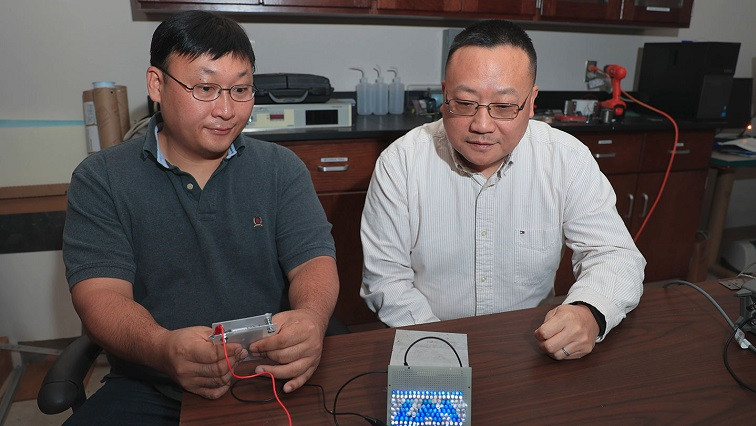UAH’s new sensor employs adhesive materials to harvest power by transferring an electric charge between two objects when they contact or slide against one another. The breakthrough is detailed in a paper published in the Journal of the Royal Society of Chemistry coauthored by Dr. Gang Wang, an associate professor in the College of Engineering, Dr. Yu Lei, chair and an associate professor of chemical and materials engineering, Dr. Ryan Conners, an associate professor of kinesiology and Dr. Moonhyung Jang, a postdoctoral research assistant at UAH, a part of the University of Alabama System.
“Wearable biosensors provide new insights to improve human performance and well-being,” Wang explains. “Our novel wearable triboelectric biosensor design consists of Scotch tape and a metalized polyester sheet. When it is pressed and released, we are able to detect human motions involving the elbow, knee, finger, eye and jaw. The design is an advance because it is self-powering, light-weight, low-cost and disposable.”
Current wearable TENG devices for the human body monitor and prevent severe body injuries for medical patients and athletes, but require nanotechnology expertise and expensive manufacturing methods to produce. “Our biosensor only involves commercial off the-shelf materials and a simple fabrication scheme compared to those used in TENG-based sensors,” Wang notes. “In addition, it does not need an external power source to function.”
The size of conventional devices also tend to be quite large, relatively speaking, when compared to the UAH device, and human skin must serve as another triboelectric layer, meaning the sensing performance could degrade with perspiration or other changes in skin condition. UAH’s device using ‘tacky’ materials simplifies the design and provides a more comfortable user experience and can detect motion involving both gross and fine motor movements.
“We have been using the sensor for a few hours in the lab test,” Wang says. “Since it is very cost effective, we could easily apply a new one if needed. The sensor can be placed anywhere on the body at the location with induced skin motion when the associated muscle is activated. For example, different knee motions can be characterized by analyzing the collected voltage signals. We also compared our sensor performance to an electromyography sensor in an isokinetic leg extension test. We are exploring the opportunities to conduct further tests by involving more human subjects and seek potential commercialization of our wearable sensor. We are working with Dr. Conners’ group to involve more human subjects this spring semester.”
Skin contraction and relaxation during body motion activate the contact and separation between the polypropylene and acrylic adhesive layers. Demonstrations have been conducted to detect various body motions, including elbow flexion, forearm protonation/supination, knee flexion/extension, proximal interphalangeal flexion/extension, eye blinking and more.
“The patent for this device was filed in November 2023,” Wang reports. “Per our experience, it will take more than one year to grant our patent after the examination.”
Read the original article on University of Alabama in Huntsville (UAH).







